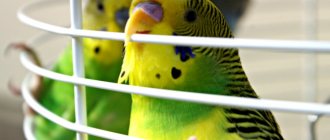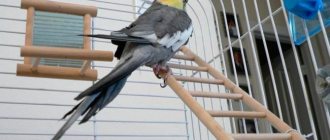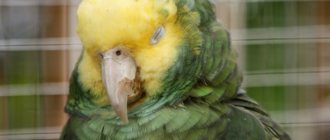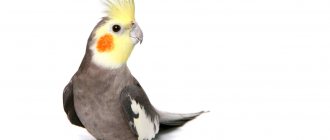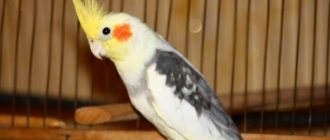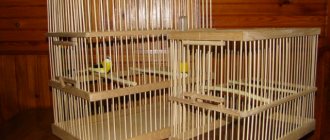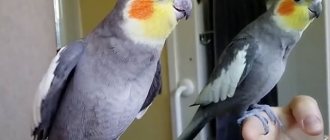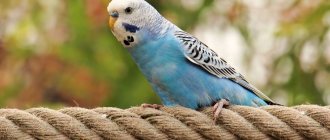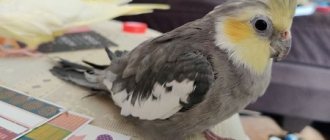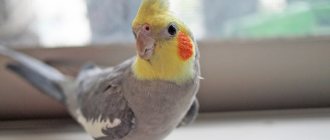Corella parrots are rightly called nymphs for their graceful appearance and noble outlines. Rosy cheeks, a crest of thin feathers on the head, a beak peculiarly curved in the shape of a smile - this is the only reason you can love such wonderful birds. And if you add their trainability and affectionate disposition, they become true friends of their owners. A cockatiel cage is an essential part of your parrot's life with you. This is the house in which the bird spends most of its time. Therefore, it is worthwhile to arrange the cage in the best possible way so that the cockatiel finds it interesting, comfortable and safe.
Choosing a cage for a cockatiel
A crest on the head, pointed long feathers on the wings and the same long wedge-shaped tail, which accounts for almost half of the entire length of the parrot - these features must be taken into account when understanding the question of what kind of cage is needed for a cockatiel.
The larger the bird's apartments, the better. Pets kept in cramped cages become apathetic, indifferent and prone to obesity. Often, due to a too limited habitat, parrots become depressed, get sick and die prematurely.
When choosing a cage, you need to take into account the features of the cockatiel:
- a bird the size of a pigeon should be kept in sufficiently spacious apartments;
- Considering that the wingspan of a cockatiel is 30 cm, the length of the cage must be at least twice as long so that it can freely spread its wings;
- parrots like to hang upside down, grasping a perch or ring, so the height of the cage should be sufficient so that the bird’s head does not touch the floor and the tail does not cling to the roof.
It is advisable to choose a cage with a retractable tray - this will help you clean it easily without disturbing the parrot. If you plan to regularly let your pet fly around the room, then the presence of such a tray is not essential. You can clean the house while the cockatiel flies around the room. Although, if you are faced with a choice: buy an apartment with or without a pallet, take the first option - removing the pallet and cleaning it from debris is easier than cleaning the bottom of the cage through a small inlet hole.
An excellent option would be an apartment with a pallet with high sides - from such a pallet there will be much less garbage flying out, and therefore spreading throughout the room.
Size
There is no single cage size for a cockatiel. Try to buy as spacious as your conditions allow. Focus on the minimum sizes that are suitable for one parrot:
- height 70 cm;
- width 40 cm;
- length 80 cm.
Length is of fundamental importance, because the parrot does not fly from top to bottom, but flies horizontally. If the length is not enough, then the parrot, flitting from place to place, can damage the plumage and even break the tail.
If you get two parrots, then increase the size of the apartment for them by one and a half to two times.
Attention! The less time the cockatiel spends outside the cage, the larger the housing should be for it.
Form
Pet stores have a wide selection of different cages for parrots in round, square, and rectangular shapes. Many owners purchase cylindrical-shaped apartments for their pets because they look very beautiful. However, for parrots, the absence of corners causes discomfort, they become disoriented in space and fall into a nervous state. In addition, if a bird grabs onto the curved roof bars, it will slip and may injure itself.
Dimensions
When choosing a cage for a cockatiel by size, keep in mind that there are no specific parameters, the main thing is that it is spacious and comfortable. Here are just the minimum sizes suitable for the life of one parrot:
- 70 cm – height.
- 40 cm – width.
- 80 cm – length.
In this case, special attention is paid to the length, since the bird flies in a horizontal direction and if it is insufficient, it can damage the feathers, wings and tail.
Keep in mind that when you buy two birds, the size of the cage almost doubles!
Ideal location
- The cage should be placed in a well-lit place, away from heating devices, in the complete absence of drafts and noise. Such gentle creatures as cockatiels, although they come from Australia, are afraid of direct rays of the sun, so they can only be placed on a window if it is possible to create shade for them.
- It is better not to house birds in the kitchen or hallway. The kitchen is a place of high humidity. Now popular Teflon-coated cookware emits fumes that are toxic to parrots when heated. In the corridor there are often drafts and sudden changes in temperature.
- A TV, refrigerator, personal computers, Wi-Fi routers and other electrical appliances that emit radio and electromagnetic waves are not the best neighbors for your pet, so move him away from them.
- You should not install an apartment with a bird in your bedroom, otherwise you will be guaranteed to wake up at dawn from the cheerful singing of a cockatiel. Unless you cover your pet’s cage with a thick cloth at night - under it the bird will silently wait for the morning to come. In her case, it occurs when you lift the fabric.
- Place the cage with one side facing the wall - this will create a feeling of security for the parrot. But living in the center of the room, the cockatiel will feel unprotected and vulnerable.
- If you have other pets that could jump on the cage and knock it over, secure the house on all sides.
- Remove from the room with the parrot all plants that are poisonous to birds, as well as objects that you would not want the bird to chew and spoil.
Important! Place your cockatiel in a room where people often visit. These parrots are very social. If they spend a lot of time alone, they will quickly become bored, become depressed, begin to pull out their feathers, and become ill.
Position your parrot's house so that when it sits on its perch, it is at eye level with you. If the bird sits higher than you, it will develop incorrect relationships with people and perceive its position in the family as dominant. If the bird sits too low, it will overwhelm it.
How to choose a chick
It is better to buy kakarika from breeders rather than from a pet store. In this case, the likelihood of getting a healthy bird is higher. In nurseries, birds are kept in good conditions, fed properly and trained to be handled. In addition, prices for parrots in stores are somewhat inflated.
The average cost of a kakarik is 3500-5000 rubles.
Before purchasing, you need to examine the chick and make sure it is healthy. Signs that your parrot is not feeling well:
- lethargy, apathy;
- disheveled and unkempt appearance;
- strange gait, loss of coordination;
- discharge from the eyes, nose;
- sneezing;
- bald spots.
Kakarik will be a wonderful pet for those who love exotic birds. He is very handsome, active, cheerful and sociable. Caring for such a bird will bring a lot of positive emotions.
How to arrange a cage
The very first thing a cockatiel should have in its cage is feeders, a drinker and perches. Feeders should be deep and wide, made of plastic, ceramic, metal or porcelain. Many owners make their own feeders from wood, coconut or clay. They are beautiful and original, but they are much more difficult to clean. There should be 2-3 feeders in the cage for different types of food: dry (grain), wet (fruits and vegetables), for mineral supplements.
The drinking bowl should be plastic or glass. To make it less contaminated by droppings, poultry fluff, food residues and grain husks, it is better to install an automatic drinking bowl. With this accessory, the water will dry out more slowly and stay fresh longer. In open drinking bowls, the water needs to be changed 1-2 times a day and constantly ensure that it is clean. Water is poured purified or bottled, intended for baby food. The water temperature should be room temperature.
The most correct option for perches for sitting a cockatiel are tree branches with bark, first thoroughly washed and scalded with boiling water. The rough structure of such perches will perfectly polish your pet’s claws and beak, and will also protect its paws from calluses, which often appear in birds sitting on plastic “seats.”
There should be at least two perches: install one of them near (not above) the feeders and drinking bowl. Do not place perches on top of each other so that the bird, sitting on the top one, does not stain the lower perch with droppings.
The diameter of the perches should be such that the bird cannot completely wrap its fingers around them. To train the paws, it would be good to equip your home with perches of different sizes.
It is also necessary to equip the parrot's cage with toys - they will entertain him when you are not at home or you are busy and cannot pay attention to him. Toys for cockatiels include wooden ladders, ropes, rings, bells, and swings.
What else should be in a cockatiel's cage? Bath for bathing - all parrots love water treatments. The bathtub does not need to be kept in your home all the time; install it at least once a week. When the parrot is bought, remove it so that it does not start drinking water from it. If you do not install a bath, make it a rule to regularly spray your pet with water from a spray bottle.
Important! Do not clutter the cage with accessories; it should be spacious and have enough space to fly.
The parrot's apartment also needs sepia, mineral stone and chalk - these accessories will provide the bird's body with useful substances, help sharpen the beak and serve as entertainment.
Appearance and size of the bird
The Kakarik jumping parrot is native to New Zealand. This is an active bird that prefers to move on the ground rather than fly. It is thanks to this feature that it received its name.
Kakarik uses his wings in exceptional cases when his life is in danger. Under natural conditions, these birds build their nests in tree hollows or under the roots of bushes.
Kakarik is a medium-sized parrot. The length of its body varies between 27-30 cm. Weight rarely exceeds 90 g. Representatives of this species have bright green or yellow plumage, a massive beak, prehensile paws and a tail 10-13 cm long.
Types of parrots
Now there are only 4 species of kakariki parrots. In fact, there used to be about 10 of them, but many disappeared from the face of the earth due to deforestation.
The remaining species are protected:
- Red-fronted jumping parrot. It is this kakarik that is most often kept at home. The main characteristics of the bird are green or yellow plumage and a red spot on the head, which affects the forehead and eye area and resembles a mask. Green red-fronted kakariki have blue undertails and the edges of their flight feathers.
- Yellow-fronted jumping parrot. This is a beautiful green parrot with a round lemon patch on its forehead and a red mark at the base of its beak. The rump is decorated with blue-gray feathers. The beak is bluish in color with a graphite tip.
- The New Zealand mountain kakarik is listed in the Red Book. This variety has rich green plumage on the upper body. The abdominal area is lighter. The head is decorated with a spot in the form of a lemon-colored cap, and a bright orange mark flaunts above the beak. The rump is gray-blue with single scarlet feathers. This species is not bred at home.
- The Antipodean kakarik is the largest of the jumping parrots. Its body is also colored green, and the feathers on its chest and belly have a beautiful golden hue. The plumage on the bend of the wing is dark blue with a violet tint, the beak is gray with a black border.
DIY cockatiel cage
Apartments for Corella parrots, sold in pet stores, look beautiful and neat, but such luxurious products are quite expensive. It is not surprising that many owners decide to make a cockatiel cage with their own hands to save money, and for the sake of their pet they put their soul into the product.
To make your pet's future home you will need:
- a sheet of fiberboard or plywood for a pallet or a plastic pallet;
- mesh 200x70 cm;
- tools (for cutting wood, stapler, drill, pliers, screwdriver, wire cutters, hammer);
- consumables (furniture hinges, glue, nails, drills, screws).
This video shows a detailed master class on making a cockatiel cage with your own hands:
Which cage is better to choose?
A rectangular house, not covered with enamel, is suitable for a cockatiel. Do not use round sockets. They look more aesthetically pleasing, but the parrot feels uncomfortable in them and often gets worried. A home for a cockatiel can be:
All metal. Nickel is best suited for these purposes. It is durable and strong. The rods let in a lot of light.
Combined. You can make it yourself. Give preference to steel wire rather than copper.
Wooden. A cockatiel cage made of wood is impractical. It is difficult to disinfect, so it is not recommended to give preference to this material.
When can you let your cockatiel out of its cage?
If you just bought a cockatiel and put it in a cage, it is important to give the parrot time to get used to it, as well as to its surroundings. After the purchase, an adaptation period is needed; the bird must feel completely safe in its home. For her, this is a reliable home, where she will always find shelter, delicious food, water and quiet rest. While she is getting used to it, you should not rush to let the cockatiel fly around the room, otherwise it will be very difficult to return her back to the cage.
Requirements for keeping poultry
This is an intelligent, inquisitive, friendly, but at the same time difficult breed to keep.
Jaco, also known as the gray parrot, is not suitable for beginners. Owners inexperienced in these matters, due to lack of experience, often destroy their pets: birds suffer from obesity, lack or excess of vitamins, or are under stressful conditions.
To keep a Gray, you will need a spacious cage made of good materials , as well as an impressive set of accessories.
Compromises are inappropriate here, as is the case with picky budgies or lovebirds, so you need to be prepared to shell out a substantial amount of money to arrange a living space for your pet.
Jaco is highly intelligent. One of the parrots ended up in the Guinness Book of Records. The bird was able to learn almost 400 words and confidently composed meaningful sentences, while speaking several languages.
Parrot aviary
If your conditions allow, it is best to keep cockatiels in an enclosure. For them there will be more space and freedom to maneuver. In such apartments you can safely install not only the necessary accessories, but also entire structures made from tree branches, on which birds can climb for their pleasure. You can equip such an enclosure with wheels to transport it to different places in the room.
You can keep several birds in the aviary, as well as set up a nesting house if you decide to start breeding cockatiels.
Material of manufacture
Wood is an environmentally friendly material, but it often becomes unusable because parrots like to chew on everything around them. In addition, such a home is more difficult to wash and clean, and insects can easily infest it. As a result, such a cage will need to be frequently treated with disinfectants, which can lead to poisoning of your pet.
Cages made of chipboard or plywood are also not suitable; they are much lighter than wood, but they can also harbor pests. At the same time, chipboard contains formaldehyde resins, which are dangerous to the health of birds. It is not recommended to choose painted, galvanized, copper materials; they can emit harmful substances.
So what kind of cage is needed for a cockatiel parrot? We list the main requirements:
- Environmental Safety.
- Easy care and disinfection.
- Lack of paint on cage elements.
- No sharp corners or protruding parts of fasteners.
Stainless steel and strong, high-quality plastic work well.
Cleaning the cage and aviary
It is very important to regularly clean the cage (aviary) from droppings, food residues, grain husks, fluff and feathers. Dirt in a parrot's home and poor care are often the cause of many cockatiel diseases. The tray needs to be cleaned daily (that's why the pull-out tray is a big advantage). Feeders and sippy cups are thoroughly washed every day. Perches and toys should be cleaned as they become dirty. The cage should be cleaned 1-2 times a week; the enclosure can be cleaned a little less often. General cleaning should be done once every six months.
Disinfection of the cage and accessories is carried out by scalding with boiling water. The same should be done with new accessories before you use them to equip your cockatiel's cage.
If you are planning to make an aviary for your parrots, watch this video (by the way, from this video it becomes clear that it is quite possible to keep a cockatiel and a budgie in the same cage):
Suitable location for the cage
After purchasing or making your own parrot house, you need to place it in the “right” place.
Optimal accommodation conditions:
- Getting enough sunlight (2-3 hours a day) or installing an additional ultraviolet source.
- No drafts.
- The presence of a “quiet zone” (one side of the house is adjacent to the wall to ensure safety).
- On a hill for a bird’s broad horizons (1-1.5 m from the floor).
Where to put it in the apartment
Not every place in the apartment is suitable for Gray. In nature, these birds live on tree branches, so the cage needs to be placed on a hill; a table or a special stand is best suited for these purposes.
The cage should be installed in such a way that the bird is in a secluded and remote place. To do this, it is placed in one of the corners of the room with limited visibility, otherwise the Gray will feel unprotected, which can soon cause the bird to behave aggressively.
Important! The cage with the parrot should not be higher than the shoulder level of the main member of the family, otherwise the bird will feel like a dominant individual. This will certainly lead to disobedience, aggression and loss of control over her behavior.
If several species of animals or birds live in an apartment, contact between them should also be limited. Each pet should have its own space and secluded corner in which it can retire from others.
